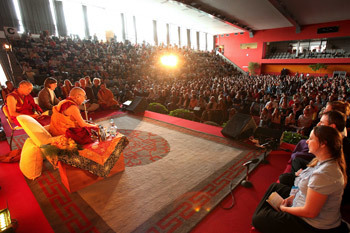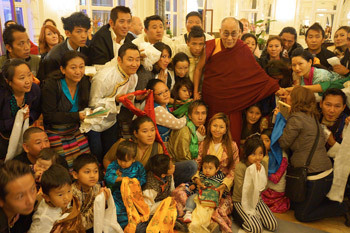Prague, Czech Republic, 15 September 2013 - On his way through the hotel lobby as he was setting out for the venue of today’s teachings, His Holiness the Dalai Lama encountered a group of Tibetans who had come from Austria where they live to listen to his public talk yesterday. They stayed overnight and were taking the opportunity to see him again before returning home.
He took a few minutes to extol to them the value and richness of the Tibetan Buddhist tradition. He stressed that Tibetan is the language most appropriate for conveying what the Buddha’s teachings mean. Therefore, it is really worth preserving. In the twenty-first century Buddhists need to read, study and come to an understanding of Buddhism, not just recite prayers and mantras without thinking about them. Many were overcome with emotion.
After taking his seat on the stage at the Podvinnýmlýn Arena, His Holiness began his talk:
“Brothers and sisters, we all want a happy life and have a right to achieve it. Mind is what makes a difference to whether we are actually happy. So, today’s talk will be about how to transform our minds.”
He said that scientists have found that compassion contributes to our having a calm mind, that leads to self-confidence, which enables us to act openly, truthfully and honestly. That leads to trust, which leads to friendship and friendship is the basis of cooperation. Without concerning ourselves with future lives, this is how we can create a happy society here and now. All 7 billion human beings need such an approach. The Buddha taught according to the dispositions of his followers rather than laying down a single dogmatic instruction. Most of the advice contained in the ‘Eight Verses for Training the Mind’ can also be found in other religious traditions.
Buddhism consists of two strands, the Pali tradition and the Sanskrit tradition. The main theme of the Pali tradition is the teaching of the Four Noble Truths. The Buddha’s teaching is based on reality, whereas our destructive emotions are based on appearances and misconceptions. We need to understand that this is not reality. Once we understand that the Third Noble Truth, cessation, is possible, we can turn to the Fourth Noble Truth, the path. The ancient Indian tradition, of which the Buddha’s teaching is part, distinguished between appearance and reality. The Buddha taught the Two Truths. He also counselled against accepting his teaching only on the basis of faith in him, encouraging his followers to investigate and experiment with what he had said.

|
His Holiness the Dalai Lama speaking during his teachings at the Podvinnymlyn Arena in Prague, Czech Republic on September 15, 2013. Photo/Jeremy Russell/OHHDL
|
Buddhism reached China in about 3rd century CE and the Tibetan Emperor developed an interest in it due to his connections with the Chinese Emperor. In 8th century he sent people to India to the University of Nalanda, home to 10,000 monk scholars. They invited Shantarakshita, a great scholar, a good monk, a philosopher, sharp logician and practitioner to come to Tibet.
“Imagine, such a venerable old man, he was over 70 years old, accepting an invitation from such a remote place. He came and encouraged the translation of Indian Buddhist scriptures into Tibetan and as something of an experiment ordained the first seven Tibetans as monks. It is a result of his kindness and his initiative that the most comprehensive presentation of Buddhism today is Tibetan.”
In 11th century, a great master of Vikramashila, Dipamkara Atisha, was invited by the King of one of the smaller realms into which Tibet had fragmented. His main disciple was Dromtonpa, who was followed by Potowa and then Sharawa and the author of this small text, Langri Tangpa.
The Buddha explained the qualities of a teacher, that he should have knowledge and experience. At the end of his life, Dromtonpa advised his disciples to consider the texts their teacher. Of the eight verses of this text seven deal with the practice of altruism, while the final verse deals with the view or wisdom.
His Holiness recalled a Sufi scholar at an inter-religious conference in India suggesting that all religious traditions address three questions: What is the self? Does it have a beginning? And does it have an end?

|
| His Holiness
the Dalai Lama speaking during his teachings at the Podvinnymlyn Arena
in Prague, Czech Republic on September 15, 2013. Photo/David Musil/Forum2000 |
“The Buddha said that just as a chariot is designated on its parts, its wheels, axles etc, the self is designated on the basis of the five aggregates of our body and mind. Buddhists say that such a self has no beginning. As to its end, most Buddhists say the self is mostly designated on the basis of the mind, and the continuity of the mind proceeding from its previous moments has no end.”
Towards the end of the morning session, His Holiness encouraged people to ask questions. One related to the direct transmission of realization, which he answered by quoting a verse from Acharya Dharmatreya’s ‘Verses about Friends’:
The Buddhas do not wash away the karma of other beings,
Nor do they remove the consequences with their hands;
They do not transfer their own realizations to others,
But they reveal the truth that liberates beings.
“What the Buddhas do,” he said, “is to teach about things as they are. This is why the Dharma and Sangha are also objects of refuge. The real protector is the Dharma, because it is the method by which we attain liberation. It’s because the Dharma came from India that we historically regard Indians as our gurus. I often describe myself as a messenger of ancient Indian thought - of ahimsa or non-violence.”
Another questioner asked, ‘If there’s no self, who reaches nirvana?’ His Holiness clarified that this indicates a misunderstanding of emptiness. He said that people often have the idea that Buddhists do not accept the existence of a self at all, which is a mistake. The Madhyamaka School posits things and events as dependent on other factors and so as existent but not inherently or independently existent.

|
His Holiness the Dalai Lama and fellow Nobel Peace Laureate Aung San Suu Kyi during their meeting in Prague, Czech Republic on September 15, 2013. Photo/Jeremy Russell/OHHDL
|
During the break for lunch, fellow Nobel Peace Laureate, Aung San Suu Kyi, who is also in Prague for the Forum 2000 meeting, had an audience with His Holiness.
Returning to his discussion of the text, His Holiness mentioned two altruistic aspirations, the first being the wish to work for the benefit of all sentient beings and the second, recognising that the proper way to help them is through fuller knowledge, being the aspiration to attain enlightenment.
“As social animals we need friends. But real friends are not attracted by fear, but by warm-heartedness and compassion. By using our intelligence we have the ability to develop concern for limitless sentient beings. Concern for others naturally gives rise to respect for them. If you show respect for your enemy, there is a chance he or she will become your friend; however, we cannot become similarly reconciled to our destructive emotions.”
He explained that when other people cause us harm and difficulties, the text advises us to make a special effort to give them help. If they repay you with trouble, it advises us to show them love and affection. His Holiness gave an example from his own experience:
“During the crisis in Lhasa in 2008 I heard about what was happening and was disturbed about the prospect of the authorities’ retaliation, a sense of helplessness similar to what I felt in March 1959. I visualized Chinese officials in front of me and visualized taking all sense of harm from them and giving them benefit. This of course made no difference to the actual events, but was of immense benefit to me.”

|
| His Holiness
the Dalai Lama speaking during his teachings at the Podvinnymlyn Arena
in Prague, Czech Republic on September 15, 2013. Photo/David Musil/Forum2000 |
His Holiness also explained how meditation on the breath can be helpful to stabilize and neutralize the mind. He demonstrated how to perform the Nine Round Breathing practice, encouraging the members of the audience to follow his example.
The final verse of the text says that all the practices it has described should not be sullied by the eight worldly thoughts concerning praise, reward and so on. When it advises us to see things and events as illusions, it is referring to their being empty of inherent existence.
His Holiness then led the audience through a simple ceremony for taking refuge in the Three Jewels and generating the awakening mind. He once again thanked the organizers for arranging this opportunity and encouraged the audience to try to incorporate what they had heard into the way they lead their lives.

















